Inhibition of MHC class I is a virulence factor in herpes simplex virus infection of mice
- PMID: 16201019
- PMCID: PMC1238742
- DOI: 10.1371/journal.ppat.0010007
Inhibition of MHC class I is a virulence factor in herpes simplex virus infection of mice
Abstract
Herpes simplex virus (HSV) has a number of genes devoted to immune evasion. One such gene, ICP47, binds to the transporter associated with antigen presentation (TAP) 1/2 thereby preventing transport of viral peptides into the endoplasmic reticulum, loading of peptides onto nascent major histocompatibility complex (MHC) class I molecules, and presentation of peptides to CD8 T cells. However, ICP47 binds poorly to murine TAP1/2 and so inhibits antigen presentation by MHC class I in mice much less efficiently than in humans, limiting the utility of murine models to address the importance of MHC class I inhibition in HSV immunopathogenesis. To address this limitation, we generated recombinant HSVs that efficiently inhibit antigen presentation by murine MHC class I. These recombinant viruses prevented cytotoxic T lymphocyte killing of infected cells in vitro, replicated to higher titers in the central nervous system, and induced paralysis more frequently than control HSV. This increase in virulence was due to inhibition of antigen presentation to CD8 T cells, since these differences were not evident in MHC class I-deficient mice or in mice in which CD8 T cells were depleted. Inhibition of MHC class I by the recombinant viruses did not impair the induction of the HSV-specific CD8 T-cell response, indicating that cross-presentation is the principal mechanism by which HSV-specific CD8 T cells are induced. This inhibition in turn facilitates greater viral entry, replication, and/or survival in the central nervous system, leading to an increased incidence of paralysis.
Conflict of interest statement
Figures


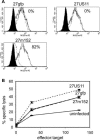
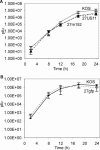
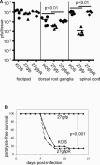
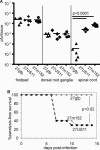
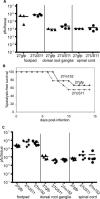

Similar articles
-
Inhibition of major histocompatibility complex class I antigen presentation in pig and primate cells by herpes simplex virus type 1 and 2 ICP47.J Virol. 1998 Jun;72(6):5076-84. doi: 10.1128/JVI.72.6.5076-5084.1998. J Virol. 1998. PMID: 9573278 Free PMC article.
-
Molecular mechanism and species specificity of TAP inhibition by herpes simplex virus ICP47.EMBO J. 1996 Jul 1;15(13):3247-55. EMBO J. 1996. PMID: 8670825 Free PMC article.
-
Effective suppression of class I major histocompatibility complex expression by the US11 or ICP47 genes can be limited by cell type or interferon-gamma exposure.Hum Gene Ther. 2003 Dec 10;14(18):1765-75. doi: 10.1089/104303403322611773. Hum Gene Ther. 2003. PMID: 14670127
-
Viral immune evasion: Lessons in MHC class I antigen presentation.Semin Immunol. 2015 Mar;27(2):125-37. doi: 10.1016/j.smim.2015.03.010. Epub 2015 Apr 15. Semin Immunol. 2015. PMID: 25887630 Review.
-
Bacterial antigen delivery systems: phagocytic processing of bacterial antigens for MHC-I and MHC-II presentation to T cells.Behring Inst Mitt. 1997 Feb;(98):197-211. Behring Inst Mitt. 1997. PMID: 9382741 Review.
Cited by
-
Herpes Simplex Virus Evasion of Early Host Antiviral Responses.Front Cell Infect Microbiol. 2019 Apr 30;9:127. doi: 10.3389/fcimb.2019.00127. eCollection 2019. Front Cell Infect Microbiol. 2019. PMID: 31114761 Free PMC article. Review.
-
Cutting edge: recombinant Listeria monocytogenes expressing a single immune-dominant peptide confers protective immunity to herpes simplex virus-1 infection.J Immunol. 2007 Apr 15;178(8):4731-5. doi: 10.4049/jimmunol.178.8.4731. J Immunol. 2007. PMID: 17404252 Free PMC article.
-
ICP47 mediates viral neuroinvasiveness by induction of TAP protein following intravenous inoculation of herpes simplex virus type 1 in mice.J Neurovirol. 2006 Dec;12(6):420-7. doi: 10.1080/13550280601009546. J Neurovirol. 2006. PMID: 17162658
-
Herpes Simplex Virus 1 (HSV-1) Infected Cell Protein 0 (ICP0) Targets of Ubiquitination during Productive Infection of Primary Adult Sensory Neurons.Int J Mol Sci. 2023 Feb 2;24(3):2931. doi: 10.3390/ijms24032931. Int J Mol Sci. 2023. PMID: 36769256 Free PMC article.
-
Oncolytic Herpes Simplex Virus-Based Therapies for Cancer.Cells. 2021 Jun 18;10(6):1541. doi: 10.3390/cells10061541. Cells. 2021. PMID: 34207386 Free PMC article. Review.
References
-
- Tortorella D, Gewurz BE, Furman MH, Schust DJ, Ploegh HL. Viral subversion of the immune system. Annu Rev Immunol. 2000;18:861–926. - PubMed
-
- Fruh K, Gruhler A, Krishna RM, Schoenhals GJ. A comparison of viral immune escape strategies targeting the MHC class I assembly pathway. Immunol Rev. 1999;168:157–166. - PubMed
-
- Fruh K, Ahn K, Peterson PA. Inhibition of MHC class I antigen presentation by viral proteins. J Mol Med. 1997;75:18–27. - PubMed
-
- Yewdell JW, Hill AB. Viral interference with antigen presentation. Nat Immunol. 2002;3:1019–1025. - PubMed
Grants and funding
LinkOut - more resources
Full Text Sources
Research Materials
Miscellaneous

